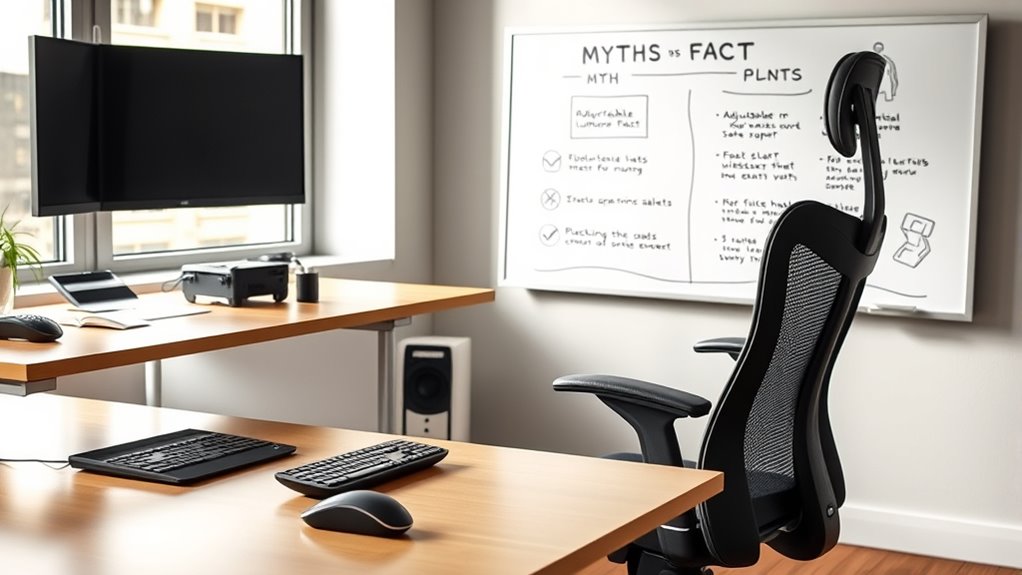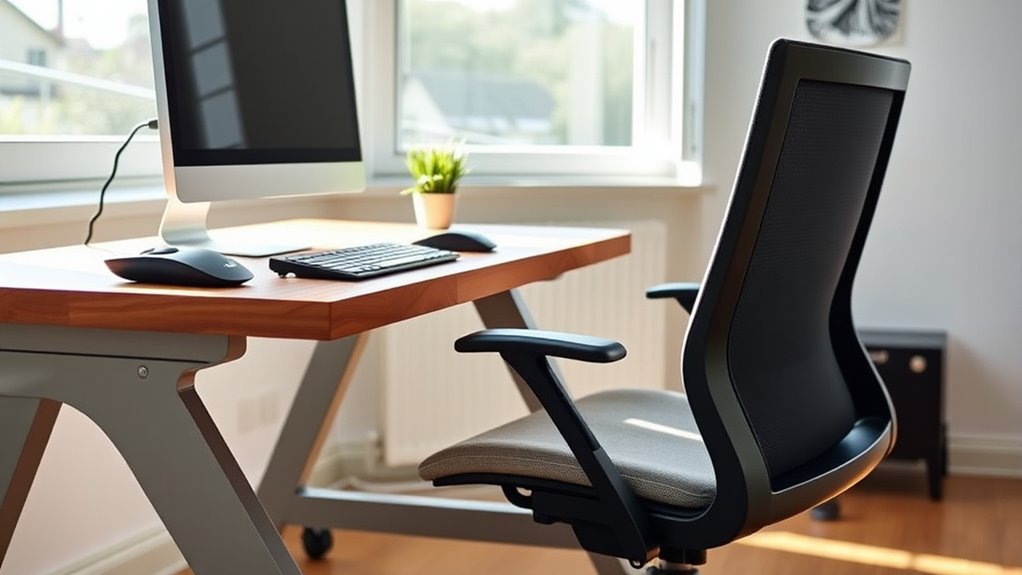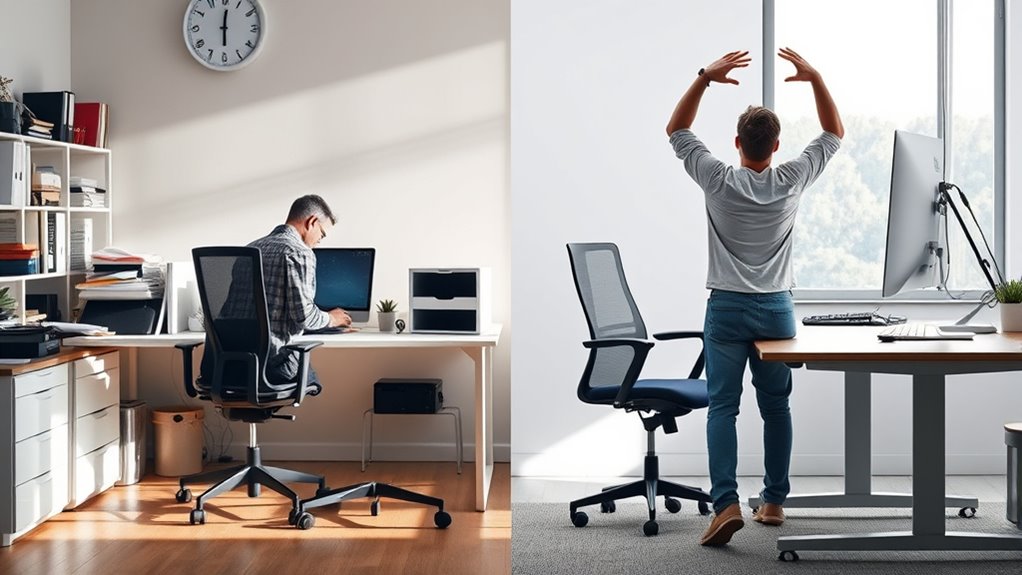Many beliefs about ergonomic desk setups are myths that can actually cause discomfort. For example, simply buying an adjustable chair doesn’t guarantee comfort unless you set it correctly. Proper desk height, monitor position, and lumbar support are essential and must be customized for you. Alternating between sitting and standing helps prevent strain. Keep in mind, small tweaks can make a big difference. Stay with us to discover more tips to optimize your workspace for comfort and health.
Key Takeaways
- An ergonomic desk setup requires proper adjustments, not just buying ergonomic furniture.
- The correct desk height allows elbows at a 90-degree angle, reducing strain.
- Monitor position at eye level and arm’s length prevents neck and eye discomfort.
- Lumbar support must align with your lower back’s natural curve for effective posture support.
- Alternating between sitting and standing enhances comfort and reduces long-term health risks.
Common Misconceptions About Ergonomic Chairs

Many people believe that simply choosing an ergonomic chair guarantees proper support, but that’s a misconception. An ergonomic chair with adjustable armrests doesn’t automatically guarantee comfort if you don’t set them correctly. Proper adjustable armrests allow you to rest your arms comfortably, reducing shoulder strain. Lumbar support is equally critical; it should fit your lower back’s natural curve to prevent slouching and back pain. Not all chairs have adjustable lumbar support, so you need to verify this feature. Simply picking a chair labeled “ergonomic” isn’t enough; you must customize it to your body’s needs. Proper adjustments make a significant difference in maintaining good posture and reducing fatigue during long hours at your desk. Additionally, selecting a chair with diverse design options can help match your workspace aesthetics and enhance overall comfort.
The Truth About Desk Height and Positioning

While an ergonomic chair is important, proper desk height and positioning are equally essential to creating a comfortable workspace. Your desk height should allow your elbows to stay close to your body and form about a 90-degree angle. Adjusting your desk so that your forearms are parallel to the floor reduces strain. Proper monitor positioning is also critical; your screen should be at eye level, about an arm’s length away, to prevent neck strain. Avoid slouching or leaning forward, which can cause discomfort over time. Ensuring your desk height supports natural arm and wrist positions, combined with correct monitor placement, promotes better posture and minimizes fatigue. Additionally, choosing a desk that aligns with your types of air purifiers can help improve overall air quality and comfort in your workspace. Remember, small adjustments can considerably improve your comfort and productivity throughout the day.
Debunking Myths About Lumbar Support

Despite common beliefs, lumbar support isn’t a one-size-fits-all solution for back comfort. It can help with posture correction, but not everyone needs it the same way. Some think lumbar support guarantees better back health, but improper use can cause discomfort or worsen posture. Remember, your goal is a neutral spine, not just added padding.
Consider these points:
- Lumbar support should support your lower back’s natural curve.
- Over-reliance may weaken core muscles over time.
- Adjustments might be necessary for different tasks.
- Not all chairs with lumbar support provide equal benefits.
- Proper positioning is key to effective posture correction.
Ultimately, lumbar support can aid back health if used correctly, but it’s not a universal fix.
Ergonomic Accessories: Necessity or Excess?

Ergonomic accessories have become popular tools to enhance workspace comfort, but their necessity often sparks debate. Are they truly essential or just excess? While some accessories, like wrist supports or adjustable keyboard trays, improve posture and reduce strain, others may offer minimal benefit relative to their cost. You need to contemplate the cost versus benefit when deciding if ergonomic accessories are worth it for you. Additionally, checking retail hours today can help ensure you visit stores at optimal times to explore ergonomic options in person.
Is Standing While Working Better Than Sitting?

Choosing between standing and sitting while working depends on your individual needs and preferences. Standing desks promote ergonomic standing, which can reduce long-term health risks associated with sitting. However, standing all day may cause discomfort or fatigue. To optimize your workspace, consider these points:
- Alternating between sitting and standing helps prevent strain.
- Ergonomic standing encourages proper posture and reduces back pain.
- Using a height-adjustable standing desk allows flexibility.
- Break periods for movement are essential regardless of your setup.
- Listen to your body; avoid standing or sitting too long at once.
- Incorporating movement breaks can further improve comfort and reduce fatigue.
While standing desks support ergonomic standing, it’s best to incorporate regular shifts and movement. This balance helps maintain comfort and productivity while reducing potential health issues.
The Role of Breaks and Movement in Ergonomic Setup

Balancing sitting and standing setups is important, but incorporating regular movement and breaks is what truly safeguards your health and comfort. Taking short breaks every 30 to 60 minutes allows you to stretch and reset your posture awareness. Incorporate stretching routines to relieve tension in your neck, shoulders, and back, reducing the risk of strain. Moving around helps improve circulation and prevents stiffness, making it easier to maintain good posture throughout the day. During breaks, stand up, walk around, or perform simple stretches to keep your muscles active. Staying mindful of your posture also plays a key role; frequent posture checks can prevent habits that lead to discomfort. Exploring sound healing techniques during breaks can also promote relaxation and reduce stress. Ultimately, making movement a regular part of your routine enhances your ergonomic setup and supports long-term well-being.
Frequently Asked Questions
How Do I Personalize My Ergonomic Desk for My Specific Body Type?
To personalize your ergonomic desk for your body type, start with customization tips like adjusting your chair height and monitor position. Use ergonomic accessories such as lumbar supports, footrests, and wrist cushions to enhance comfort. Pay attention to your posture and make small tweaks as needed, ensuring your workspace fits your unique dimensions. Regularly reassess and adjust these elements to maintain proper alignment and prevent strain throughout your workday.
Can Ergonomic Setups Prevent All Types of Work-Related Musculoskeletal Issues?
Imagine Sarah improved her office posture with ergonomic accessories, reducing her neck pain markedly. While ergonomic setups can’t prevent all musculoskeletal issues, they do greatly lower the risk. Proper chair support, monitor height, and keyboard placement promote better posture, but staying active and taking breaks is essential. You can minimize discomfort by customizing your workspace and using ergonomic tools, yet some issues might still arise without overall healthy habits.
Are There Specific Ergonomic Principles for Different Work Environments or Industries?
Yes, there are industry-specific ergonomics and work environment adaptations tailored to your needs. You should consider industry-specific ergonomics, which address unique tasks and hazards, and customize your workspace accordingly. For example, a manufacturing worker needs different support than someone in an office. By applying these principles, you can reduce discomfort and injury risk, ensuring your setup fits your specific work environment and promotes better health and productivity.
How Often Should I Reassess and Adjust My Ergonomic Workspace?
Think of your ergonomic workspace as a living organism that needs regular care. You should monitor your setup daily to catch subtle discomforts and adjust as needed. Every few months, schedule a dedicated reassessment to fine-tune your posture, monitor routine, and equipment. This proactive approach keeps your workspace in harmony, preventing strain and boosting comfort, ensuring your environment adapts to your evolving needs like a well-tuned instrument.
What Are the Signs That My Ergonomic Setup Is Causing Discomfort or Harm?
You’ll notice posture problems like neck, shoulder, or back pain, and you might feel numbness or tingling in your hands or arms. Repetitive strain injuries can cause persistent discomfort or stiffness. If your workspace isn’t aligned properly, you may experience headaches, eye strain, or fatigue. Pay attention to these signs, and adjust your ergonomic setup promptly to prevent further discomfort or long-term harm.
Conclusion
Remember, creating an ergonomic workspace is like tending a garden—you need the right tools, proper positioning, and regular care. Imagine yourself gently adjusting your chair, aligning your monitor, and taking mindful breaks, all to nurture your comfort and health. By debunking myths and embracing true ergonomic practices, you’ll cultivate a workspace where you feel balanced, supported, and ready to thrive. Your ideal setup isn’t a myth; it’s within your reach with a little mindful effort.








